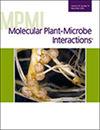Mina Ohtsu, Joanna Jennings, Matthew Johnston, Andrew Breakspear, Xiaokun Liu, Kara Stark, Richard J Morris, Jeroen de Keijzer, Christine Faulkner
求助PDF
{"title":"对植物组织中效应细胞间迁移率的测定确定了胞间连丝的高迁移率和间接操纵。","authors":"Mina Ohtsu, Joanna Jennings, Matthew Johnston, Andrew Breakspear, Xiaokun Liu, Kara Stark, Richard J Morris, Jeroen de Keijzer, Christine Faulkner","doi":"10.1094/MPMI-05-23-0052-TA","DOIUrl":null,"url":null,"abstract":"<p><p>In plants, plasmodesmata establish cytoplasmic continuity between cells to allow for communication and resource exchange across the cell wall. While plant pathogens use plasmodesmata as a pathway for both molecular and physical invasion, the benefits of molecular invasion (cell-to-cell movement of pathogen effectors) are poorly understood. To establish a methodology for identification and characterization of the cell-to-cell mobility of effectors, we performed a quantitative live imaging-based screen of candidate effectors of the fungal pathogen <i>Colletotrichum higginsianum</i>. We predicted <i>C. higginsianum</i> effectors by their expression profiles, the presence of a secretion signal, and their predicted and in planta localization when fused to green fluorescent protein. We assayed for cell-to-cell mobility of nucleocytosolic effectors and identified 14 that are cell-to-cell mobile. We identified that three of these effectors are \"hypermobile,\" showing cell-to-cell mobility greater than expected for a protein of that size. To explore the mechanism of hypermobility, we chose two hypermobile effectors and measured their impact on plasmodesmata function and found that even though they show no direct association with plasmodesmata, each increases the transport capacity of plasmodesmata. Thus, our methods for quantitative analysis of cell-to-cell mobility of candidate microbe-derived effectors, or any suite of host proteins, can identify cell-to-cell hypermobility and offer greater understanding of how proteins affect plasmodesmal function and intercellular connectivity. [Formula: see text] Copyright © 2024 The Author(s). This is an open access article distributed under the CC BY 4.0 International license.</p>","PeriodicalId":19009,"journal":{"name":"Molecular Plant-microbe Interactions","volume":" ","pages":"84-92"},"PeriodicalIF":3.2000,"publicationDate":"2024-02-01","publicationTypes":"Journal Article","fieldsOfStudy":null,"isOpenAccess":false,"openAccessPdf":"","citationCount":"0","resultStr":"{\"title\":\"Assaying Effector Cell-to-Cell Mobility in Plant Tissues Identifies Hypermobility and Indirect Manipulation of Plasmodesmata.\",\"authors\":\"Mina Ohtsu, Joanna Jennings, Matthew Johnston, Andrew Breakspear, Xiaokun Liu, Kara Stark, Richard J Morris, Jeroen de Keijzer, Christine Faulkner\",\"doi\":\"10.1094/MPMI-05-23-0052-TA\",\"DOIUrl\":null,\"url\":null,\"abstract\":\"<p><p>In plants, plasmodesmata establish cytoplasmic continuity between cells to allow for communication and resource exchange across the cell wall. While plant pathogens use plasmodesmata as a pathway for both molecular and physical invasion, the benefits of molecular invasion (cell-to-cell movement of pathogen effectors) are poorly understood. To establish a methodology for identification and characterization of the cell-to-cell mobility of effectors, we performed a quantitative live imaging-based screen of candidate effectors of the fungal pathogen <i>Colletotrichum higginsianum</i>. We predicted <i>C. higginsianum</i> effectors by their expression profiles, the presence of a secretion signal, and their predicted and in planta localization when fused to green fluorescent protein. We assayed for cell-to-cell mobility of nucleocytosolic effectors and identified 14 that are cell-to-cell mobile. We identified that three of these effectors are \\\"hypermobile,\\\" showing cell-to-cell mobility greater than expected for a protein of that size. To explore the mechanism of hypermobility, we chose two hypermobile effectors and measured their impact on plasmodesmata function and found that even though they show no direct association with plasmodesmata, each increases the transport capacity of plasmodesmata. Thus, our methods for quantitative analysis of cell-to-cell mobility of candidate microbe-derived effectors, or any suite of host proteins, can identify cell-to-cell hypermobility and offer greater understanding of how proteins affect plasmodesmal function and intercellular connectivity. [Formula: see text] Copyright © 2024 The Author(s). This is an open access article distributed under the CC BY 4.0 International license.</p>\",\"PeriodicalId\":19009,\"journal\":{\"name\":\"Molecular Plant-microbe Interactions\",\"volume\":\" \",\"pages\":\"84-92\"},\"PeriodicalIF\":3.2000,\"publicationDate\":\"2024-02-01\",\"publicationTypes\":\"Journal Article\",\"fieldsOfStudy\":null,\"isOpenAccess\":false,\"openAccessPdf\":\"\",\"citationCount\":\"0\",\"resultStr\":null,\"platform\":\"Semanticscholar\",\"paperid\":null,\"PeriodicalName\":\"Molecular Plant-microbe Interactions\",\"FirstCategoryId\":\"99\",\"ListUrlMain\":\"https://doi.org/10.1094/MPMI-05-23-0052-TA\",\"RegionNum\":3,\"RegionCategory\":\"生物学\",\"ArticlePicture\":[],\"TitleCN\":null,\"AbstractTextCN\":null,\"PMCID\":null,\"EPubDate\":\"2024/2/26 0:00:00\",\"PubModel\":\"Epub\",\"JCR\":\"Q2\",\"JCRName\":\"BIOCHEMISTRY & MOLECULAR BIOLOGY\",\"Score\":null,\"Total\":0}","platform":"Semanticscholar","paperid":null,"PeriodicalName":"Molecular Plant-microbe Interactions","FirstCategoryId":"99","ListUrlMain":"https://doi.org/10.1094/MPMI-05-23-0052-TA","RegionNum":3,"RegionCategory":"生物学","ArticlePicture":[],"TitleCN":null,"AbstractTextCN":null,"PMCID":null,"EPubDate":"2024/2/26 0:00:00","PubModel":"Epub","JCR":"Q2","JCRName":"BIOCHEMISTRY & MOLECULAR BIOLOGY","Score":null,"Total":0}
引用次数: 0
引用
批量引用

 求助内容:
求助内容: 应助结果提醒方式:
应助结果提醒方式:


